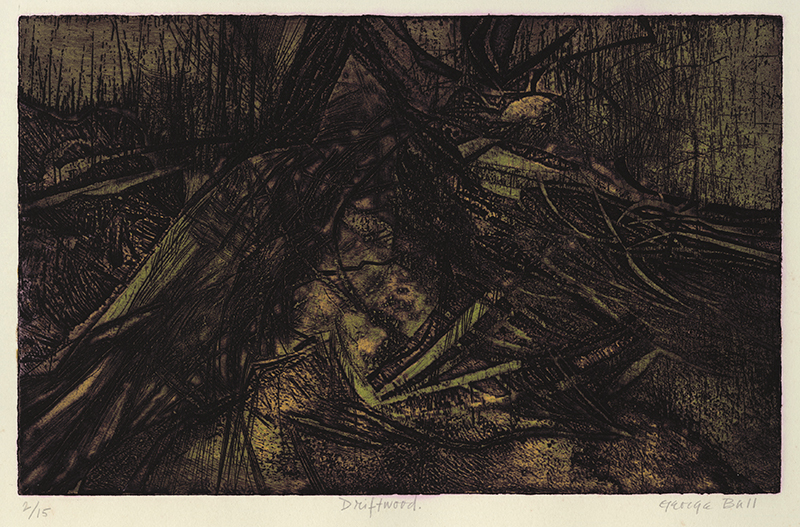
19th, 20th & 21st Century Fine Prints
707-546-7352 · fax 707-546-7924 · web: www.annexgalleries.com · email: artannex@aol.com
Driftwood by George Ball

Driftwood
George Ball
Driftwood
George Ball
1929 - 2010 (biography)The influence of George Ball's friend and mentor, British artist Stanley William Hayter is evident in the San Francisco-born artist's finely nuanced intaglio, "Driftwood". In "Driftwood" Ball uses the Atelier 17 color viscosity technique, or simultaneous color printing, to create layers of texture and tonality to the gestural linear composition done with open-bite etching, engraving and aquatint. The effect is similar to examining the organic random structures of the driftwood and flotsom washed up by the tide and entrapped in the root system of a tree.
Interestingly, Hayter had come to San Francisco in the late 1940s to guest-teach at the California School of Fine Arts (now the San Francisco Art Institute), bringing the Abstract Expressionist printmaking techniques formed in his famed Atelier 17 workshop to the West Coast - but if he and Ball ever crossed paths at this juncture, there is no record of it. Prior to Ball's fortuitous introduction to Hayter in Paris in 1958, he was primarily a landscape painter and had achieved critial aclaim in his hometown. It was a Fullbright Scholarship that led him from San Francisco to Paris to study at the Sorbonne, and then to Atelier 17. After trying his hand at printmaking, he stayed on to work as Hayter's assistant indefinitely. He would remain Paris until his death in 2010.
George Ball was born in San Francisco, California on 10 August 1929, the only son of Edwin Ball and Elisabeth Cross. Through the efforts of his mother, he was exposed to art at an early age by visiting museums in San Francisco. After graduating from high school in 1947, Ball attended Stanford University, studying law and art history, graduating in 1952. During his first trip to Italy in 1955, he immersed himself in Venetian and Florentine art then returned to San Francisco to pursue another year studying graphic art at Stanford. However, Ball showed little aptitude for advertising art and, against the advice of his teachers, he decided to become a painter.
In 1956, he participated in his first group exhibitions at the Richmond Art Center, the de Young Museum, and the Museum of Modern Art in San Francisco. The Gump's Gallery in San Francisco organized his first solo exhibitions. His paintings, mostly landscapes, received awards and public acclaim. Ball received a Fulbright Program grant in 1958 which he used to study at the Sorbonne in France. In Paris, Ball continued to paint and while there met printmaker Stanley William Hayter. Hayter befriended the young artist who eventually became his assistant at the Ranson Academy where Hayter had re-established Atelier 17.
In 1960, Ball bought a printing press that he installed in his Parisian apartment. Located on the fifth floor of an old building on rue de la Huchette, Ball transformed the space into a workshop. Artists Lil and Cécil Michaelis lived on the first floor and Abidin Dino and his wife Güzin lived across the hall. This community of artists gathered every summer with Hayter on the property of the Michaelis at Harmas in Aix-en-Provence. In 1960, Ball met Raymond Haasen, engraver and master printer, who became his friend and assistant, printing more than one hundred engravings for him.
In May 1968, Ball produced a large body of gouaches, drawings, and paintings. From 1970 to 1980, he devoted himself to working with young engravers at Atelier 17 or in his own workshop on rue de la Parcheminerie. During this period, he was commissioned to create monumental works on aluminum panels.
The deaths of Lil Michalelis in 1987, Stanley William Hayter in 1988, and Adibin Dino in 1993 plunged Ball into a depression and disarray from which he finally emerged during a long stay at the Franciscan hermitage of La Cordelle in Vézelay. There he met Brother Ambroise Negrel and Father Joseph Fondeur, who participated in both his religious conversion and a form of artistic renaissance. The Church of Saint-Séverin in Paris commissioned him to paint two large oils on canvas depicting angels, now exhibited in the presbytery.
In 1982, the bibliophile association "les 101" asked Ball to illustrate Les Cahiers de Malte Laurids Brigge by Rainer Maria Rilke. Three years were necessary to complete the work. In 1994, Ball and Richard Nelson, a former student, collaborated to illustrate the work St. Jean de la Croix, Malgré la Nuit. Each artist created six engravings and the work was published by Atelier Georges Leblanc and Thierry Bouchard. That same year, through his gallerist André Biren, Ball met novelist and literary columnist Michel Déon. Several works of art and an important correspondence testify to their friendship.


